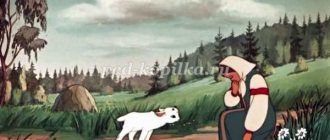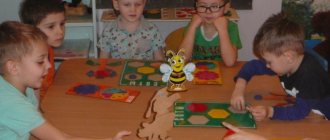Selection “The literary word: riddles, sayings, nursery rhymes, poems, fairy tales about food!”
Theodore and Feofan bequeathed the walnut tree to their children. In total, they had ten children, and each became a master in his own field. When people thanked them for their work, they answered, smiling: “It was the walnut that strengthened our memory and helped us learn, so we should thank him.”
The walnut tree lived for many centuries and grew taller than a ten-story building. All the descendants of Theodore and Feofan received only one branch of the mighty walnut tree as an inheritance, but there were enough nuts for everyone, because the tree produced more than 100 thousand nuts annually.
Questions and tasks for the fairy tale:
• Do you think that if it weren’t for the judge’s wise decision, would the neighbors ever have made peace?
• What decision would you make if you were a judge?
• Write down the recipes for the fruit and walnut pies baked by order of the judge.
• Make up a story about a walnut who gave wise advice to everyone.
• Who or what does a walnut remind you of?
• What other trees do people plant in honor of newborns?
• Who in your family loves walnuts the most?
• Make a craft from walnut shells and give it to your friend.
MAGIC PUMPKIN
Good fairies often use pumpkins to grant wishes to people with pure hearts. The fairy made a golden carriage out of a pumpkin for Cinderella; In the fields of the most industrious people sometimes a pumpkin full of gold coins grows. I'll tell you about pumpkins that grew in Laos, near a small house. A lonely old man lived in this house. Pumpkins were the main decoration of his room: in the corners, turban-shaped pumpkins hung on vines, shimmering with colors, like New Year's toys; On the shelf above the fireplace lay big-eyed, warty pumpkins, and in the middle of the room a large golden pumpkin hung from the ceiling. A long time ago, my grandmother left the old man an inheritance of this house, a handful of seeds and advice: “Plant pumpkins near the house. Only pumpkins can grow in such barren land, and they will feed you.” The old man listened to his grandmother's advice and did not regret it. The pumpkins grew well. They could be stored for a year or even two, and there was always a supply of food in the house. One day an old man asked God to send him a new harvest of pumpkins. Suddenly, a golden pumpkin on the ceiling opened, and a golden-haired girl in a fire-orange dress came down from there. She handed the old man a vessel full of pumpkin seeds and said: “The Fairy of Life asked me to give you these seeds. Grow new pumpkins from them and heal people with them.” The beautiful girl disappeared, and the old man never saw her again. However, since then he always asked the pumpkin for advice, and in a melodious voice she explained to him how to find a way out of any trouble. From the seeds that the golden-haired girl gave, the old man grew new pumpkins, and every day he began to walk around the village with a basket of pumpkins. - Eat, grandma, these magic pumpkins ,
- he persuaded the lonely, weak old woman.
- Look at me, I ate pumpkins and became twice as young. “Nothing will bring back my youth.” “I wish I could get out of bed just once more,” my grandmother dreamed. A week later, meeting her at the well, the old man said: “You see, you didn’t believe that my pumpkins would raise you to your feet.” He explained to the happy mother, who thanked him for the birth of her son: “Don’t thank me, but the pumpkin that you ate for a whole year!” It was she who, with the help of her wonderful vitamin E, saved you from infertility. I advise you to continue to eat more pumpkin. It will protect you from inflammation, strengthen the baby’s bones, and make your milk abundant. One day an old man came into the hut of a poor woodcutter. The tree touched him and the wound on his leg festered. “I’m not a doctor, but my magic pumpkin is no worse than a doctor.” Now I will wash the wound with fresh pumpkin juice and make a bandage with pumpkin pulp so that the suppuration will go away. “Eat these pumpkins: they contain a huge amount of zinc, which is useful for healing wounds,” the old man explained. Soon the woodcutter brought the old man a bundle of fresh firewood and said with gratitude: “Grandfather, I will always bring you firewood for free.” Look, not a trace of my wound remains. “Thank not me, but the magic pumpkin,” answered the old man, “and take a couple more with you.” In addition to zinc, pumpkin contains a lot of copper and iron ,
which is an excellent remedy for strengthening the body. The old man helped village beauties maintain a fresh complexion using a mask made from pumpkin pulp. Even a local rich man who suffered from obesity was helped by a magic pumpkin to lose weight and dissolve kidney stones. When all the fields in the area burned out from a terrible drought, the pumpkin in the old man’s garden turned green, as if nothing had happened. At this time, she alone supplied the bees with nectar. The orange, huge flowers fed several bees at a time with nectar, and the old man produced unusually tasty pumpkins. Early one morning, a small wild bee woke up the old man and buzzed: “We have prepared honey for you in gratitude for the nectar and pollen from your pumpkin flowers.” “Thank you,” said the old man, “but I should thank you.” You did a great job to ensure that the pumpkin flower is well pollinated. The next year it rained all summer, and the crops in the fields were wet. The magic pumpkin advised the old man to hang the pumpkins on supports so that the breeze would blow through them. The harvest was a great success, and the old man fed the entire village with his pumpkins. Then the elders from five villages in the area invited the old man to a council and said: “Our fields are depleted, and the people are starving.” They say you have a magic pumpkin that gives wise advice. Let him advise how we should continue to live. “There’s no need to ask for advice here,” answered the old man, “just plant a pumpkin: it’s not afraid of drought or rain, and the harvest is excellent.” You just need to make sure that the weeds do not choke out the seedlings, and then the pumpkin will protect itself with its large leaves. They listened to the elders and planted pumpkin seeds everywhere, which the old man gave them. From these very seeds, pumpkins with amazing healing properties spread across the earth. Since then, in Laos and China, pumpkin has been called the king of vegetables and a symbol of rebirth, and its seeds are considered the food of immortality.
“Tell a fairy tale from a picture” Goal: To develop the ability to retell a familiar fairy tale based on illustrations. Equipment: Plot pictures for fairy tales or a series of plot pictures. Progress of the game: The teacher shows the child a story picture. The child names the fairy tale and describes what is depicted in it. If desired, the child can tell the story in full. “Who is the extra character?” Goal: To clarify children’s knowledge of the content of fairy tales and fairy-tale characters. Equipment: figurines of fairy tale heroes from various types of theater. How to play: The heroes of one of the fairy tales with one extra character are placed on the table. For children 5 years old, it's called a fairy tale. Children must name who is extra, who is lost. Children after five years old must name which fairy tale the heroes are from and who is lost. Lotto “Find fairy-tale characters” Goal: To develop the ability to recognize a fairy tale and its characters. Equipment: Large cards with the plot of a fairy tale; small cards depicting fairy-tale heroes of a fairy tale Game progress: Children have large cards with the plot of a fairy tale. The presenter shows small cards. The child, who has a hero from a fairy tale depicted on a large card, names the hero and takes him for himself. The first one to fill out his card wins. “Who gets it together faster” Purpose: To consolidate the content of fairy tales. Equipment: Figures of fairy-tale characters, illustrations of fairy tale plots. How to play: The plots of different fairy tales are laid out on the tables. Children are given figurines or illustrations of fairy-tale characters. Children dance to the music with their characters. At the teacher’s command, children find the desired plot and pose their own fairy-tale hero. “Name a fairy tale” Purpose: To consolidate the content of fairy tales and fairy-tale characters. Equipment: A playing field on which the plots of different fairy tales are placed in turn; cube. Progress of the game: The child throws the dice. Makes a move in accordance with the dropped number of points. Names the fairy tale he fell into and its characters. If he succeeds, he continues the game in order of priority. If he fails, he returns to the start. "What changed?" Goal: To consolidate the ability to distinguish and name fairy tale characters. Equipment: figures (illustrations) from a tabletop theater, from one or more fairy tales (complication). How to play: In front of the children are figures of heroes from one fairy tale (or from several). The names of the heroes are clarified. Then the children close their eyes and the teacher removes one toy. Children open their eyes and have to say what has changed. “Guess the fairy tale” Purpose: To consolidate the names of fairy tales and fairy-tale characters. Equipment: Cards depicting an excerpt from a fairy tale or a fairy-tale character. Progress of the game: the cards are turned over, the children come up in turn, choose a card, name a fairy tale or a character. If the answer is correct, the card is taken away; if not, it is put back in its place. At the end of the game, the winning cards are counted.
Aren't you tired? Then let's play some more!






